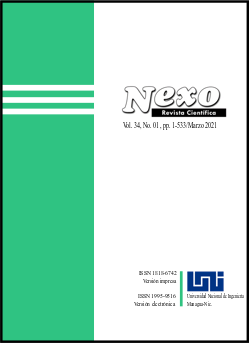Las complejidades de las medidas estadísticas de nuevos procesos sociales: un sistema de indicadores Downshifting
DOI:
https://doi.org/10.5377/nexo.v34i01.11313Palabras clave:
cambio descendente, medición de cambio descendente, indicadores de cambio descendente, sistema indicador de cambio descendenteResumen
En el siglo XXI, se están generalizando cada vez más los nuevos procesos sociales que solían considerarse ilógicos, inusuales e incluso imposibles en el pasado reciente. Indudablemente, el cambio descendente que implica el rechazo deliberado de los beneficios de la civilización moderna debe considerarse como uno de esos procesos. En varios países y rincones del planeta, la escala del desarrollo del cambio descendente ha adquirido ahora una magnitud tan grande que actuar como si nada estuviera sucediendo sería imposible e incorrecto. Mientras tanto, todavía no se ha formado en la sociedad una percepción inequívoca de la reducción de marcha como un proceso exclusivamente favorable o desfavorable. En este contexto, los intentos de medir y evaluar estadísticamente los diversos parámetros del cambio descendente despiertan un gran interés desde el punto de vista científico y práctico. Sin embargo, hay que admitir que la ciencia estadística va un poco por detrás de las demandas y necesidades actuales de la sociedad, ya que el sistema de indicadores descendentes proporciona su característica integral y permite una respuesta relativamente clara a la pregunta sobre el papel real de un proceso social tan inusual. aún no se ha desarrollado. En este contexto, el presente artículo examina las características específicas del análisis cuantitativo del downshifting, analiza varios enfoques para la creación de un sistema de indicadores estadísticos de downshifting, y presenta las propuestas de los autores considerando la estructura y componentes del sistema de indicadores de downshifting que permiten no solo de manera integral demostrando la escala, estructura, distribución e intensidad de este proceso, pero también abordando sus resultados y consecuencias socioeconómicas.
Descargas
1257
Descargas
Publicado
Cómo citar
Número
Sección
Licencia
Los autores que publican en Nexo Revista Científica están de acuerdo con los siguientes términos:
- Los autores conservan los derechos de autor y conceden a la revista el derecho de la primera publicación bajo la licencia Creative Commons Attribution License, que permite a otros compartir el trabajo con un reconocimiento a la autoría de la obra y a la publicación inicial en Nexo Revista Científica.
- Los autores pueden establecer por separado acuerdos adicionales para la distribución no exclusiva de la versión de la obra publicada en la revista (por ejemplo, en un repositorio institucional o en un libro) con el reconocimiento de su publicación inicial en Nexo Revista Científica.
- Se permite y se anima a los autores a difundir sus trabajos electrónicamente (por ejemplo, en repositorios institucionales o en su propio sitio web) antes y durante el proceso de envío, ya que puede dar lugar a intercambios productivos, así como a una citación más temprana y mayor de los trabajos publicados.










